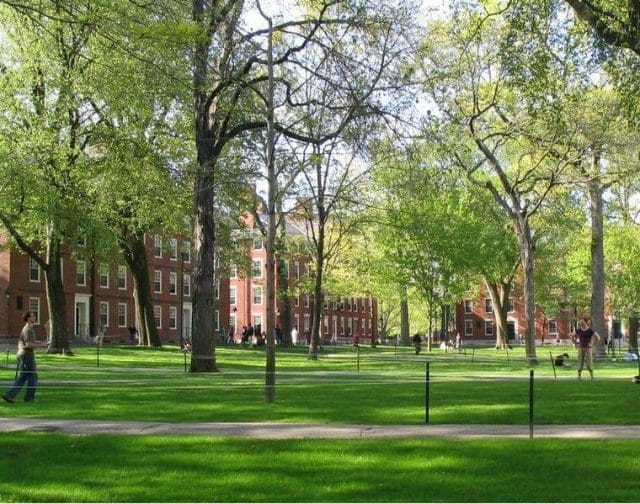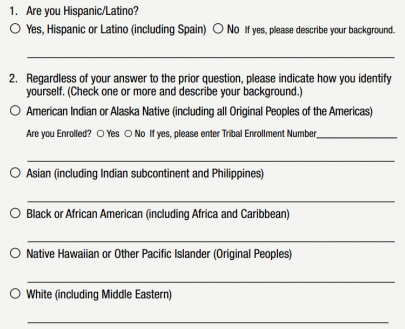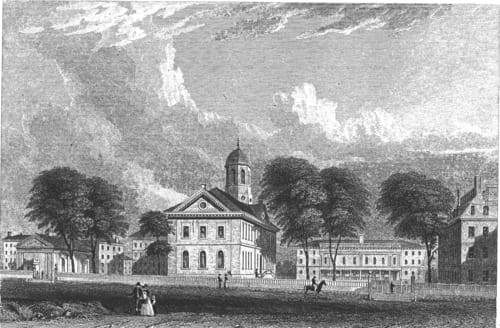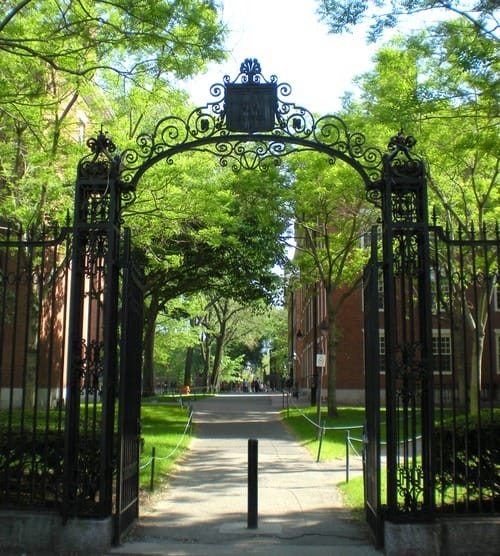Applying to colleges in the United States is a stressful, competitive process. In 1970, the acceptance rate at Stanford University was 22.4%. Today, only 5.7% of applicants are accepted into the school. Across the country, nearly every top school like Harvard, MIT and Yale are reporting record-low acceptance rates. The number of students applying to elite colleges is exploding, and those applicants have better test scores than ever. It’s never been harder to get into a selective university.
Asian-American students face an extra source of stress: deciding whether to respond to the application question asking for their race and ethnicity. True or not, there is a perception that Asians are at a disadvantage in the college admissions process. Asian students going through the process comment:
“I didn’t want to put ‘Asian’ down… because my mom told me there’s discrimination against Asians in the application process… Not to really generalize, but a lot of Asians, they have perfect SATs, perfect GPAs, … so it’s hard to let them all in”
…
“As someone who was applying with relatively strong scores, I didn’t want to be grouped into that stereotype… I didn’t want to be written off as one of the 1.4 billion Asians that were applying.”
Is their fear justified? Is it statistically more difficult to be accepted into top universities if you are Asian? Ivy League colleges and their ilk deny this to be true, but what does the data say?
Statistical Evidence of Discrimination Against Asians
Those who contend that selective colleges discriminate against Asians point to three main sources of data.
First, some top colleges have in the past (though not recently) released detailed admissions data. Second, in 1996 California banned state universities from considering race and ethnicity in admissions decisions. The result is a natural experiment where you can see what happens to the number of Asians accepted before and after this decision. Finally, researchers have tried to quantify whether the number of high performing Asians has been increasing and whether that has corresponded to more placements in selective schools.
The most cited, well-researched evidence that it’s harder for Asians to get into top colleges is presented by Princeton professor Thomas Espenshade and his collaborator Alexandria Radford in their 2009 book No Longer Separate, Not Yet Equal. In this book, the researchers analyzed the complete application histories of eight “elite” universities in 1997 (the last year these schools released this information). While the data is over 15 years old, it’s the most complete dataset publicly available.
Espenshade and Radford use the 1997 data to show the overall acceptance rates by race and class at public and private universities with highly selective admissions criteria. We will focus on the private institutions data since most elite schools fit in that category.

As the numbers show, Asians have the lowest acceptance rates at the selective private universities in this sample. The authors then lay out how admissions rates vary by race and SAT score:

Asians have the lowest acceptance rate for each test score bucket.
While these descriptive statistics are useful, there could be additional factors at play. The authors next build up a regression model that controls for the applicants’ state of residence and academic performance. Model 5 shows the impact of race on likelihood of admissions after controlling for these factors at these private schools. (You can read about the rest of the models and methodology here.)
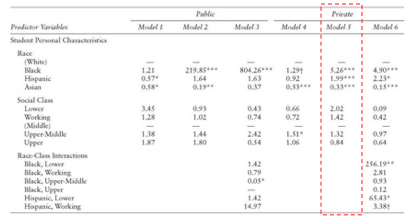
As model 5 shows, Asian applicants have 67% lower odds of admission than white applicants with comparable test scores.
Finally, the authors convert these findings into more intuitive results. With white students as a baseline, they look at how much of a bump or penalty students receive in terms of SAT scores on the basis of their race:

They find that being Asian is the equivalent of a 140 point score penalty on your SAT when applying to top private universities. For example, a white student that scored 1360 on the SATs would be on equal footing with an Asian student that scored 1500.
Ultimately, the authors come short of making any conclusions about whether Asians are discriminated against. Their data indicates that Asians needed higher standard test scores than whites to get accepted to top schools in 1997, but this doesn’t consider other parts of a “holistic” admissions process such as athletic prowess, legacy status (being the child of an alum), or quality of admissions essays and recommendation letters.
The next piece of evidence frequently cited in the debate is the the admissions data of public universities in California (Berkeley, UCLA, UCSD, Davis, etc). In 1996 it became illegal for these schools to consider race in their admissions criteria. This created a natural experiment showing what happens to the number of Asian students at a school when admissions officers are not allowed to consider that they are Asian.
Since these are state universities, the admissions data, which includes the race of students, is publicly available. Let’s consider the data for UC Berkeley, the most prestigious and selective public university in California.
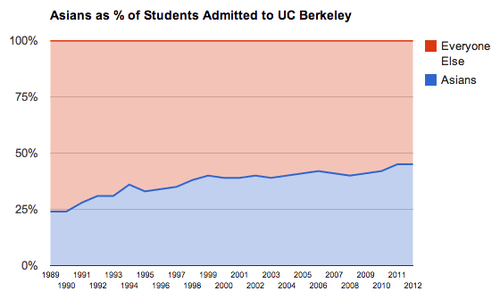
Over the the past 20+ years, students accepted into UC Berkeley has exploded from 25% Asian in 1989 to 45% Asian today.
While this is interesting, it’s not necessarily proof that Asians are discriminated against prior to the 1996 ruling. If the number of college-aged Asians rose dramatically during this time period, it would be natural that there are more Asians accepted at Berkeley.
So let’s look at what has happened to the the acceptance rate over time. Did it get easier for Asians to get in after you could no longer consider their ethnicity? Of course, it’s gotten a lot harder for everyone to get in over the last 20 years, so let’s compare the Asian acceptance rate to the acceptance rate for everyone else at Berkely.
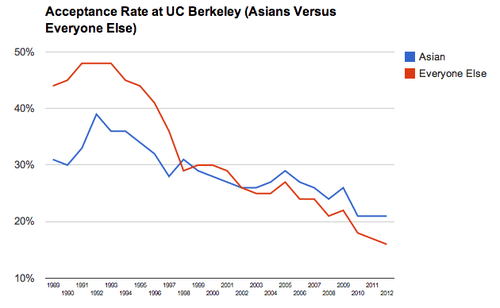
In 1989, it was a lot harder for an Asian-American to get into UC Berkeley than the average non-Asian. By 2012, that is no longer the case at all.
Finally, the fact that the growth in the Asian population has not been reflected in their numbers at top schools is cited as well. Not only have the the number of college-aged Asians increased in the last two decades, the number of academically high performing Asians has as well. This viewpoint is summarized quantitatively by Ron Unz, founder of The American Conservative – a publication that is quite vocal about this issue:

The data Unz has compiled shows that while the number of college aged Asians has increased dramatically, their presence at top schools has shrunk or remained flat. By contrast, Cal Tech, which has a strictly race neutral admissions policy, has kept pace with the growth in the the Asian population. (This is also true of the University of California school we previously examined). Unz also contends you should see a lot more Asians at these Ivy League schools during this time, because they were kicking ass and taking names academically:
“Asians were less than 10 percent of U.S. Math Olympiad winners during the 1980s, but rose to a striking 58 percent of the total during the last thirteen years 2000–2012. For the Computing Olympiad, Asian winners averaged about 20 percent of the total during most of the 1990s and 2000s, but grew to 50 percent during 2009–2010 and a remarkable 75 percent during 2011–2012.
….
“The statistical trend for the Science Talent Search finalists, numbering many thousands of top science students, has been the clearest: Asians constituted 22 percent of the total in the 1980s, 29 percent in the 1990s, 36 percent in the 2000s, and 64 percent in the 2010s.
…
“Although Asians represented only about 11 percent of California high school students, they constituted almost 60 percent of the [National Merit Scholars]… In Texas, Asians are just 3.8 percent of the population but were over a quarter of the NMS semifinalists in 2010, while the 2.4 percent of Florida Asians provided between 10 percent and 16 percent of the top students… Asian over-representation was enormous [in New York]: the Asian 7.3 percent of the population—many of them impoverished immigrant families—accounted for almost one-third of all top scoring New York students.”
According to standardized tests and talent competitions, there is strong evidence that Asian Americans aren’t just doing pretty well, they’re completely dominating.
The Counter Argument
“Harvard College welcomes talented students from all backgrounds, including Asian-Americans… The admissions committee does not use quotas of any kind.”
– Jeff Neil, Harvard University Communications Department
It’s hard to find evidence that contradicts what’s presented above. While the data is either stale or limited, all of it indicates that Asians are under-represented at top schools. At the same time, admissions officers vigorously deny that there is any bias against Asian Americans. Moreover, this author knows former admissions officers and they’re all really nice people. It’s very hard for this author to imagine them hatching dastardly plots to keep Asians from their schools.
The gist of the argument that top schools don’t discriminate against Asians is that academic qualifications are only one of the many criteria used in a “holistic” admissions process. There are so many students with great academic qualifications relative to the spots available that academic qualifications almost don’t matter for serious candidates. Given that so many students meet the minimum academic criteria (which are high), successful applicants need to contribute more than just brain power to their school of choice.
This viewpoint is crystallized by Rod Bugarin, former member of Brown and Columbia admissions committees:
“Yes, if you considered only test scores, Asian and Asian-American students would seem to be at a disadvantage.”
….
“But the students who rise to the top of the highly personal and subjective admissions process are those who have submitted the strongest comprehensive applications.”
The unstated implication of this quote is that while Asians have high test scores, the rest of their application, on average, is deficient in some manner.
The next argument is that top schools aren’t actually biased against Asians, they’re biased against people that aren’t athletes or children of alumni. In 1990, the US Office of Civil Rights concluded an investigation into whether Harvard discriminated against Asians. The commission concluded that most of the under representation could be explained by the fact that few Asians were recruited athletes or children of alumni.
This might explain why the number of Asians at Harvard was relatively low in 1990, but it doesn’t explain why that number is still about the same after two decades of growth in the Asian share of America’s population.
Finally, there are those who argue that the “Asian discrimination question” is merely being used as a “wedge issue” to overturn affirmative action and lower the number of blacks, hispanics, and historically under-represented minorities on campus. While this is a valid concern, it evades the question of whether Asians are held to a different academic standard than the baseline group, whites. That’s the question we’re focusing on.
Reading the universities’ responses to accusations of an anti-Asian bias in admission decisions is frustrating because they don’t provide any data to back their refutations. They simply state that there is no discrimination today. They refuse to even release recent admissions data in order to refute the old and stale data that suggest Asians have to score much higher on the SATs than whites in order to be accepted into college.
Holistic admissions policies, as they stand today, are a subjective black box that could be used for any purpose – good or evil, inclusion or exclusion. In absence of providing any data, Ivy League admissions offices are saying, “Trust us, we use our power for good.” But how have universities used this power in the past? Are they really worthy of trust?
A History of Discrimination
Colleges in the United States likely think of themselves as progressive institutions. They have forward-thinking faculties, a stated objective of inclusion, and commitments to public service. This author might even personally think they are wonderful, progressive places. But no generation ever thinks of themselves as being racist or discriminatory, even when they are. If the data suggests you’re discriminating against a group, and you’re forced to come up with qualitative, opaque explanations for why the discrepancy exists, historically, that has been a bad sign.
Has the Ivy League, for example, proven itself as an institution that should be given the benefit of the doubt over accusations of discrimination? Schools in the Ivy League have been around for almost 400 years. For the vast majority of that time, women, blacks, or anyone other than white men were not allowed to attend. During this period, the educators, admissions officers, and alumni undoubtedly considered themselves part of a great institutions bringing light to the world, but the hindsight of history proves they had racist and sexist admissions policies.
Holistic admissions criteria emerged at Ivy League schools in the early 20th century and were almost immediately twisted for virulently anti-semitic purposes. Until the 1920s, students took an admissions test and those that did well on the test were admitted to the colleges “almost entirely on the basis of academic criteria.” This resulted in lots of Jewish men on the campus of Harvard, Princeton, and Yale.
An alumni visiting the Harvard campus around this time was shocked by the scene:
“Naturally, after 25 years, one expects to find many changes, but to find that one’s University had become so Hebrewized was a fearful shock. There were Jews to the right of me, Jews to the left of me, in fact they were so obviously everywhere that instead of leaving the Yard with pleasant memories of the past I left with a feeling of utter disgust of the present and grave doubts about the future of my Alma Mater.”
It’s around this time that Ivy League schools switched from a strictly quantitative system of test scores to a more subjective, holistic approach. The holistic approach was used to squelch diversity and the number of Jews in American universities then plummeted. Wikipedia documents:
For instance, the admission to Harvard University during that period fell from 27.6% to 17.1% and in Columbia University from 32.7% to 14.6%. Corresponding quotas were introduced in the medical and dental schools resulting during the 1930s in the decline of Jewish students: e.g. in Cornell University School of Medicine from 40% in 1918–22 to 3.57% in 1940–41, in Boston University Medical School from 48.4% in 1929–30 to 12.5% in 1934–35.
Around this time, the concept of giving prominence to legacy of Alumni started to gain prominence. Wikipedia elaborates:
Legacy preference for university admissions was devised in 1925 at Yale University, where the proportional number of Jews in the student body was growing at a rate that became alarming to the school’s administrators. However, even prior to that year, Yale had begun to incorporate such amorphous criteria as ‘character’ and ‘solidity’, as well as ‘physical characteristics’, into its admissions process as an excuse for screening out Jewish students; but nothing was as effective as legacy preference, which allowed the admissions board to summarily pass over Jews in favor of ‘Yale sons of good character and reasonably good record’, as a 1929 memo phrased it.
As late as the 1950s, prominent administrators at Harvard and Yale publicly commented on the appearance of the kind of students they sought. David Brooks of the New York Times summarizes:
Paul Buck argued in several essays that Harvard did not want to become dominated by the “sensitive, neurotic boy,” by those who are “intellectually over-stimulated.” Instead, he said, Harvard should be seeking out boys who are of the “healthy extrovert kind.” In 1950, Yale’s president, Alfred Whitney Griswold, reassured alumni that the Yale man of the future would not be a “beetle-browed, highly specialized intellectual, but a well-rounded man.”
It wasn’t until the 1950s that these sort of barriers were dropped against Jewish Americans and their numbers started to rise again at elite universities.
The above section isn’t meant to imply that Asians are the “new Jews.” It’s meant to show the potential consequences of “black box” admissions criteria and how disgusting those practices can be. Opaque processes can be subject to considerable abuse.
Conclusion: Why This Matters
The elite schools of America hold considerable power. For much of this nation’s history they’ve been the gatekeepers of wealth, power, and knowledge. Entry into their club confers privilege – it’s a signal to the world that you are among the chosen to be selected for high paying jobs, leadership positions, and power.
In today’s world, it seems hard to swallow that federally-funded, tax-exempt institutions could continue to shroud their selection criteria in secrecy. It’s likely that admissions officers are wonderful people, but what if every time they see an Asian applicant, they subconsciously think “Another piano playing, hard working kid, with perfect SAT scores. Good candidate, but we can’t have a campus entirely full of people like that.” Is that an okay thought to think today? Does it lead to outcomes that represent our societal values? Will it be okay to think that way in 20 years?
The nature of what is “merit” is constructed by those who control the admissions decisions. Before the early 20th century, it was how good you were at Latin and Greek. Later, what kind of family you came from become important. Today, the holistic admissions criteria are a black box.
Many Asians believe they are being held to a different academic standard than whites. This belief might be true or false, but universities should release the data that puts the debate to rest. But if Asians are under represented on American college campuses relative to what their academic performance would predict, this seems like the sort of discrimination that history would ultimately judge very harshly.
This post was written by Rohin Dhar. Follow him on Twitter here or Google. To get occasional notifications when we write blog posts, sign up for our email list.




